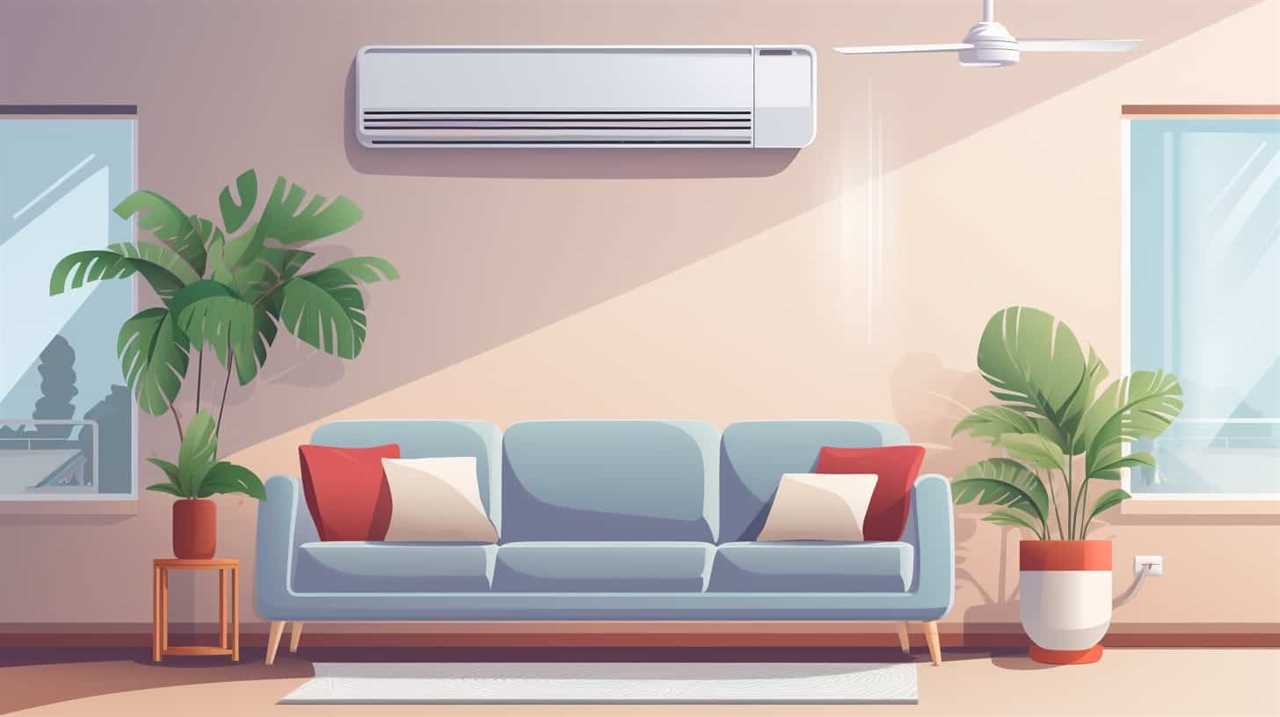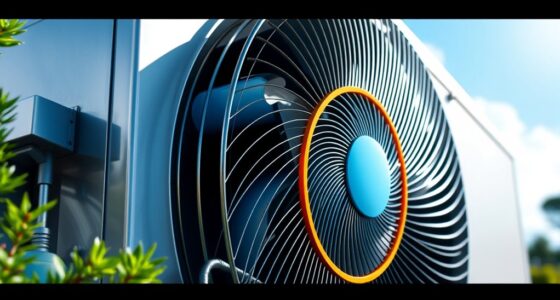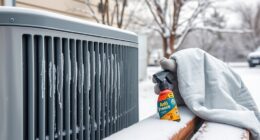We believed that selecting the ideal heat pump would be easy. Little did we realize, we were about to embark on a journey into the realm of energy efficiency ratings. But don’t worry, we are here to help you navigate through the maze of EERs and SEERs.
In this article, we’ll break down the importance of energy efficiency ratings and give you the tools to compare and select the best heat pump for your needs. So, buckle up and let’s dive in!
Key Takeaways
- Energy efficiency ratings are crucial when selecting a heat pump as they determine its performance, cost-effectiveness, and environmental impact.
- Look for heat pumps that are Energy Star certified and use eco-friendly refrigerants to ensure they meet strict energy efficiency standards and minimize environmental harm.
- Consider the SEER and HSPF ratings, which indicate the cooling and heating efficiency of the heat pump respectively, to make an informed decision.
- Balancing energy efficiency and cost is important, and evaluating the potential long-term savings and payback period can justify the higher initial investment in an energy-efficient heat pump.
The Importance of Energy Efficiency Ratings
We need to consider the importance of energy efficiency ratings when selecting heat pumps. Energy efficiency ratings play a crucial role in determining the performance and cost-effectiveness of a heat pump. By choosing a heat pump with a high energy efficiency rating, we can reap several energy-saving benefits.
Firstly, a more efficient heat pump consumes less energy, resulting in lower electricity bills.

Secondly, it helps reduce our carbon footprint by minimizing greenhouse gas emissions. Heat pumps with higher efficiency ratings use less fossil fuel and produce fewer harmful emissions.
Factors to Consider in Energy Efficiency Ratings
When considering energy efficiency ratings, it’s important to take into account various factors. These factors can greatly influence the overall performance and efficiency of heat pumps. Here are four key factors to consider:
-
Energy Star Certification: Look for heat pumps that have been certified by Energy Star. This certification ensures that the product meets strict energy efficiency standards, resulting in reduced energy consumption and lower utility bills.
-
Environmental Impact: Consider the environmental impact of the heat pump. Look for models that use eco-friendly refrigerants and have minimal greenhouse gas emissions. This helps to reduce your carbon footprint and contribute to a greener future.

-
Seasonal Energy Efficiency Ratio (SEER): Pay attention to the SEER rating of the heat pump. This rating indicates the cooling efficiency of the unit. Higher SEER ratings mean better energy efficiency and lower operating costs.
-
Heating Seasonal Performance Factor (HSPF): Consider the HSPF rating, which measures the heating efficiency of the heat pump. Higher HSPF ratings indicate better energy efficiency and lower heating costs.
Considering these factors will help you make an informed decision when selecting a heat pump.
Now, let’s delve into understanding the energy efficiency ratio (EER).

Understanding the Energy Efficiency Ratio (EER)
The EER rating is a crucial factor to consider when evaluating the energy efficiency of heat pumps. It measures the cooling efficiency of a heat pump at a specific outdoor temperature and indoor humidity level. Calculating EER involves dividing the cooling capacity of the heat pump in British thermal units per hour (BTU/hr) by the power input in watts. The higher the EER rating, the more efficient the heat pump is in converting electrical energy into cooling power. This means that a heat pump with a higher EER rating can provide the same cooling effect while consuming less energy. The benefits of energy efficiency are numerous, including reduced energy costs and lower environmental impact. In the table below, we compare the EER ratings of three heat pumps to demonstrate the potential energy savings:
| Heat Pump Model | Cooling Capacity (BTU/hr) | Power Input (Watts) | EER Rating |
|---|---|---|---|
| Model A | 12,000 | 1,200 | 10 |
| Model B | 12,000 | 1,000 | 12 |
| Model C | 12,000 | 800 | 15 |
As you can see, Model C has the highest EER rating, indicating that it is the most energy-efficient heat pump among the three. Transitioning into the next section, let’s explore the Seasonal Energy Efficiency Ratio (SEER) and its significance in evaluating heat pump efficiency.
Exploring Seasonal Energy Efficiency Ratio (SEER)
To further evaluate the efficiency of heat pumps, it’s important to explore the Seasonal Energy Efficiency Ratio (SEER). The SEER rating is a measure of a heat pump’s cooling efficiency over an entire cooling season. Here are four key points to understand about SEER ratings:
-
SEER rating explanation: The SEER rating is calculated by dividing the total cooling output of a heat pump over a typical cooling season by the total energy consumed during that period. It represents the cooling output per unit of energy consumed.

-
Higher is better: A higher SEER rating indicates a more efficient heat pump. Heat pumps with higher SEER ratings can provide greater energy savings and lower utility bills.
-
Minimum SEER requirements: The U.S. Department of Energy sets minimum SEER requirements for heat pumps. Currently, the minimum SEER rating for new heat pumps is 14.
-
Climate considerations: SEER ratings are based on standard conditions, so actual efficiency may vary depending on climate and usage patterns. It’s important to consider climate when selecting a heat pump to ensure optimal efficiency and comfort.
Understanding the SEER rating is crucial in evaluating heat pump efficiency and making informed decisions when choosing a system for your home.

Comparing Energy Efficiency Ratings: What to Look for in a Heat Pump
We should consider the efficiency ratings of heat pumps and prioritize the abstract noun of energy efficiency when comparing different models.
When comparing energy efficiency ratings of heat pumps, it’s important to look for a high Seasonal Energy Efficiency Ratio (SEER) and a high Heating Seasonal Performance Factor (HSPF). The SEER measures the cooling efficiency of the heat pump, while the HSPF measures the heating efficiency.
A higher SEER and HSPF indicate a more energy-efficient heat pump, which can result in significant energy savings over time.
It’s also important to consider the cost of the heat pump, as a more energy-efficient model may have a higher upfront cost but can save you money in the long run through reduced energy bills.

Frequently Asked Questions
How Does the Energy Efficiency Rating Impact the Overall Cost of a Heat Pump?
The energy efficiency rating directly affects the overall cost of a heat pump by impacting monthly utility bills. Higher ratings result in lower energy consumption, leading to decreased expenses and environmental benefits.
Are There Any Government Incentives or Rebates Available for Purchasing a Heat Pump With a High Energy Efficiency Rating?
Yes, there are government incentives and rebates available for purchasing a heat pump with a high energy efficiency rating. These incentives provide financial benefits and can help offset the cost of the heat pump.
Can a Heat Pump With a Lower Energy Efficiency Rating Still Provide Sufficient Heating and Cooling for My Home?
A heat pump with a lower energy efficiency rating may still provide sufficient heating and cooling for our home, but it may not offer the same level of energy savings as a higher-rated heat pump.
How Often Should I Have My Heat Pump Serviced to Maintain Its Energy Efficiency Rating?
To maintain our heat pump’s energy efficiency rating, we should have it serviced annually. This frequency ensures optimal performance and prevents potential breakdowns. Regular maintenance also extends the lifespan of our unit.

Are There Any Additional Maintenance or Operational Costs Associated With Heat Pumps With Higher Energy Efficiency Ratings?
There can be additional costs associated with heat pumps with higher energy efficiency ratings, but the long-term savings outweigh them. It’s important to consider maintenance and operational expenses when selecting a heat pump.
Conclusion
In conclusion, when selecting a heat pump, it’s crucial to consider energy efficiency ratings. These ratings, such as the Energy Efficiency Ratio (EER) and Seasonal Energy Efficiency Ratio (SEER), provide valuable information on the performance and efficiency of the heat pump.
By choosing a heat pump with high energy efficiency ratings, we can’t only save money on energy bills but also contribute to a more sustainable future.
Remember, ‘Every penny saved is a penny earned.’










